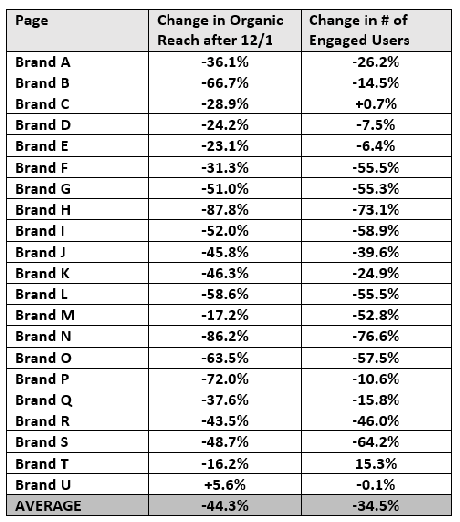 Are managing your client’s brand page on Facebook and feel like you have done everything to share great content, but still not generating the level of engagement you were enjoying a few months back? You’re not alone. Facebook recently made changes to its algorithm and the reach of brand pages has been negatively affected. According to Jim Tobin, President of Ignite Social Media, “Ignite analysts reviewed 689 posts across 21 brand pages (all of significant size, across a variety of industries) and found that, in the week since December 1, organic reach and organic reach percentage have each declined by 44 percent on average, with some pages seeing declines as high as 88 percent. Only one page in the analysis had improved reach, which came in at 5.6 percent.”
Are managing your client’s brand page on Facebook and feel like you have done everything to share great content, but still not generating the level of engagement you were enjoying a few months back? You’re not alone. Facebook recently made changes to its algorithm and the reach of brand pages has been negatively affected. According to Jim Tobin, President of Ignite Social Media, “Ignite analysts reviewed 689 posts across 21 brand pages (all of significant size, across a variety of industries) and found that, in the week since December 1, organic reach and organic reach percentage have each declined by 44 percent on average, with some pages seeing declines as high as 88 percent. Only one page in the analysis had improved reach, which came in at 5.6 percent.”
He also noted that brand page reach is now often under 3%. About a year ago, Facebook contended brand page posts could potentially reach 16% of the brand fans. Ignite’s analysis shows that’s not the case any more. In fact, according to Ignite, the average post on popular brand pages reach only 2.5 percent of their fans. This is bad news for brands who have invested a lot of effort and resources building an audience on Facebook. We all know the importance of organic reach and that organic content and engaged fans is the holy grail when it comes to success at social media marketing. Organic has always produced better results than paid post. And who really wants to pay Facebook to boost posts with a best case scenario reach of 3%? At what point do brands just figure out that there’s got to be a better, more effective, more cost effective way?

Facebook Changes And The Implications To Brands
Facebook stated recently that it’s necessary to favor “high quality articles” over “the latest meme” to keep users coming back. I think that’s a crock actually, and the latest in Facebook’s ever-changing methodology and quest to be even more profitable. High quality articles that have a reach of 3% don’t do much of anything for a brand, now do they? And sometimes, a Grumpy Cat photo is actually just what your brand’s fans want to see.
But what are the broader implications for brands? We all know Facebook is in business to make money. One way to increase revenue is to encourage brands to pay for reach. In the past, organic reach was based on EdgeRank. Simply put, this meant posts with the most number of likes, shares and comments received better position in the newsfeed. This encouraged brands to create high quality content that was more meaningful for their target audience. In addition, many now brands supplement their organic content with paid promoted posts. According to Tobin, it may now be harder for brands to justify paying for a promoted post when they still only reach such a small percentage of their audience – and one that they’ve worked hard and spent a lot of time and money building.
What to Do Now — Own Your Data
Brands need to seriously rethink their strategy when it comes to engaging with their audience. Social media has been great for brands in helping them reach more customers, deliver better customer service, identify influencers and the like and a host of other things. But whether you’re a large company or a small one, putting all your eggs in the Facebook basket is a risk. Nowadays, most brands use social media to promote their products and services and there’s certainly nothing wrong with that. When those same companies rely only on social platforms, like Facebook, instead of creating and growing their own databases, there’s a disconnect in the marketing department’s strategy. You can spend a ton of money building a fan base on Facebook and other social media networks, but the reality is that you don’t OWN access to those fans. You don’t have access to their data, they’ve not opted into your email list and you don’t have any way of reaching them that’s not ultimately controlled by those social networks.
As an aside, this is where I think LinkedIn is so valuable. At least if you spend your efforts building a LinkedIn group you can interact with them (at no charge), you can market to them via emails and you can potentially get a lot of value out of the time, effort and money you spent building that group. Conversely, you can build a huge community on Facebook and not have any real access to them — other than by paying to promote your posts and/or advertise.
If you’re smart and using your power on Facebook to drive fans to opt in to a newsletter so that you can market to them outside of Facebook, that’s terrific. But in all too many instances, that’s not something we see that’s an integral part of a Facebook strategy. This is where we pause and pay our respects to MySpace, Friendster and GoogleWave. As those former greats remind us, it’s also really important to understand that the world, especially as it relates to the Web and technology, is constantly evolving and changing. What happens when you’ve not made any efforts to connect your Facebook (or any other social media) fans to you in a way that allows you to reach them, outside of the realm of the social network?
Use social media channels, by all means, but know that the greatest value they can provide you is when they can help you drive prospective customers to landing pages where you can convert them to leads, when they can drive traffic to your website or blog where they’ll find such good stuff that they can’t live without that they’ll opt into your enewsletters or, even better, fill out a contact form because they want whatever it is you’re serving up.
Conclusion
It’s hard to deny that it’s still important for brands to have a presence on Facebook with it’s 1.19 billion users, but will there come a time when Facebook strikes a balance between making users happy and rewarding brands’ efforts? Facebook should be looking out for brand marketers and business owners who want to use and leverage the site to grow their businesses, connect with their fans and, of course, sell stuff. After all, they’re the ones who buy advertising, spend money on campaigns and keep Facebook profitable. We agree with Jim when he said that the changes to the algorithm should be based on the strength of the brand’s content and not on the assumption that everyone suddenly wants to see more news articles in their newsfeed. I certainly don’t want to see news articles from brands, I want to see news articles from trusted news sources – don’t you?
I met Jim at Expion’s Social Summit this past fall and his presentation converted this data geek to an instant fan. He and his team are definitely one of our go-to resources for social media marketing insight and if you’re smart, you’ll stalk them on a regular basis. Here is Jim’s original post on this topic: Facebook Brand Pages Suffer 44% Decline Since December 1. Jim is also the author of Earn It. Don’t Buy It. The CMO’s Guide to Social Media in a Post Facebook World. If you’re a CMO and charged with integrating social into your marketing strategies, this is quite likely a must-read.
What’s going on for you on Facebook? Has the reach of your Facebook brand pages declined recently? What’s your take on the recent changes? Will the changes affect your marketing strategy and campaign plans for 2014?
Other resources on this topic:
Business Insider: Facebook Screws Social Media Marketers
AdAge: Facebook Admits Organic Reach is Falling Short, Urges Marketers to Buy Ads
SearchEngineWatch: Facebook Admits: Expect Organic Reach for Pages to Continue Declining
photo credit: rishibando via photopin cc
Facebook Brand Reach Dwindling: What To Do Now is a post from: V3 Kansas City Integrated Marketing and Social Media Agency

